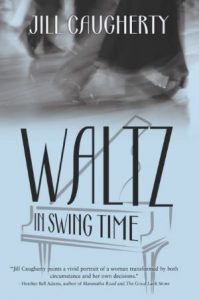On Revision: Reframing the House, Painting, and Applying the Finishing Touches
by Jill Caugherty
 Over ten years ago, in 2008, I began writing my historical novel, WALTZ IN SWING TIME. I had no firm plans other than to base the story loosely on my grandmother’s life and learn from my mistakes with an earlier shelved autobiographical manuscript.
Over ten years ago, in 2008, I began writing my historical novel, WALTZ IN SWING TIME. I had no firm plans other than to base the story loosely on my grandmother’s life and learn from my mistakes with an earlier shelved autobiographical manuscript.
Little did I realize that the novel would morph drastically as I gained experience with the writing process, reshaped and revised. For that matter, I didn’t anticipate that it would take nearly a decade to complete the first draft, and another three years to make it publication-ready. In hindsight, I understand now that the first draft is like an architect’s blueprint of the house, combined with the structure’s framing, plumbing, and wiring. The house, however, still requires inspection, drywall, paint, and finishing touches.
In the novel’s early stages, my writing time was stretched thin, balanced between a baby daughter and a full-time job in high tech. As a result, I wrote when I could, primarily in the evenings or on weekends. Because my schedule was inconsistent, sometimes weeks or even months lapsed between writing sessions, especially before our daughter turned school age. Nonetheless, when I had a few dedicated hours, I picked up where I left off, absorbed myself in the characters, and advanced the plot. One advantage of the long lapses between writing sessions is that I re-read earlier passages with a fresh perspective and often revised dialogue or descriptions before starting new passages. Meanwhile, I read compulsively, and noted the techniques that worked well in my favorite novels.
In 2016, after a family trip to Zion National Park, a central setting in my novel, I finally finished the first draft and felt satisfied. After all, I reasoned, I had revised as I wrote. As I shopped the novel to literary agents, I didn’t realize that much of my work was still ahead. Although I had created the blueprint of the house, I hadn’t altered anything structural that didn’t pass inspection, nor had I applied the drywall, paint, or crown molding.
After initial interest from agents trickled in, and I was invited to share my full manuscript, I received rejections, with the comments that too much of the action took place in 2006, and the novel was not fast-paced. After taking time to consider the feedback, I knew the agents were right. Some of my favorite historical novels alternate between past and present, but the action in the past is always vivid and immediate.
With this knowledge, I reframed what hadn’t passed inspection: I rewrote the beginning of all chapters that took place in the nineteen-thirties, making the action more immediate, and omitted any references to 2006 in those chapters. After a few more months, I also took the plunge and eliminated or shortened a few of the 2006 chapters.
Following a 2017 fiction master class in which I offered my first chapter for discussion, I thought about the participants’ comments, then made further revisions to apply drywall and paint by adding another character to the first scene. Deciding that music is an important motif in the novel, I revised the first chapter so that the protagonist plays the piano, and included foreshadowing about future events.
My revised draft attracted attention from other agencies, and I was thrilled to receive a revise-and-resubmit request from a prestigious New York agent. In a few sentences, she explained that I needed to “raise the stakes” early on, and make all action central to the main characters. She also noted that she didn’t feel sympathetic toward one of the characters in 2006.
Her excellent advice motivated me. After processing her comments, I reframed further by eliminating chapters in which the action was auxiliary to the central characters, and revising scenes with the protagonist’s daughter. Although the agent ultimately rejected my revised draft, I knew that her feedback had helped strengthen and tighten the novel’s structure.
Over the next few months, I re-painted and applied the crown molding to improve the story in ways I thought would continue to raise the stakes and entice the reader: adding hooks to the end of each chapter, shortening scenes, enhancing others, and creating consistent motifs.
This year, a small publisher made a contract offer on WALTZ IN SWING TIME, with a publication date of April 2020. As I complete the last editing phase before submitting the final draft, I continue to apply the finishing touches to the literary house that I’ve crafted: shortening redundant words and phrases, including a dramatic scene to demonstrate the protagonist’s anger and grief over the sale of her piano, even raising a few final stakes to show the extreme conditions of one character’s circumstances and to reveal the steep price the protagonist paid in starting her new life.
In retrospect, I understand that the painting and finishing touch process is just as important as the blueprint and rough plumbing phase. Taking time between applications, as well as observing and modeling fine handiwork on other houses, can help the builder in the finishing phase. In fact, for perfectionists who constantly notice a missing spot of paint or a smudge on the wall, it can be difficult to know when to declare the house move-in ready.
With any luck, now that I have experienced this process from start to finish, I will shorten the total time on my next project to under a decade!
—
A Stanford graduate and award-winning marketing manager with over twenty-five years of experience in the high tech industry, Jill Caugherty lives in Raleigh, North Carolina with her husband and daughter. Her short stories have been published in 805Lit and Oyster River Pages, and her debut short story was nominated for the 2019 PEN/Robert J. Dau Short Story Prize for Emerging Writers. Set in Depression-era Utah, Jill’s debut novel, Waltz In Swing Time, will be published by Black Rose Writing in April 2020. Learn more at www.jillcaugherty.com.
WALZ IN SWING TIME, Jill Caugherty
 Growing up in a strict Utah farm family during the Great Depression, Irene Larsen copes with her family’s hardship by playing piano. Even after an unthinkable tragedy strikes, Irene clings to her dream of becoming a musician. When a neighbor’s farm is foreclosed, Irene’s brother marries the neighbor’s daughter, who moves in with the Larsens and coaches Irene into winning leading roles in musicals. Clashing with her mother, who dismisses her ambition as a waste of time and urges her to become a farmer’s wife, Irene leaves home.
Growing up in a strict Utah farm family during the Great Depression, Irene Larsen copes with her family’s hardship by playing piano. Even after an unthinkable tragedy strikes, Irene clings to her dream of becoming a musician. When a neighbor’s farm is foreclosed, Irene’s brother marries the neighbor’s daughter, who moves in with the Larsens and coaches Irene into winning leading roles in musicals. Clashing with her mother, who dismisses her ambition as a waste of time and urges her to become a farmer’s wife, Irene leaves home.
During a summer gig at Zion National Park, where Irene sings in a variety show for Depression-weary tourists, she meets professional dancer Spike, a maverick who might be her ticket to a musical career. But does pursuing her dream justify the steep price of losing her home and family?
Alternating between Irene’s ninetieth year in 2006 at an assisted living home and her coming-of-age in the thirties, Waltz in Swing Time is a poignant tale of mother-daughter relationships, finding hope amidst loss, and forging an independent path, against all odds. It will resonate with readers of Paula McClain, Rae Meadows, Therese Anne Fowler, and Amy Tan.
“Over the course of this bright novel, Caugherty manages to seamlessly transition between two wildly different decades while maintaining a fresh, youthful voice—which is essential in a book about an ambitious dreamer who struggles through hard times… It’s a hopeful yet realistic story, and the letters that Irene receives from her future husband are a particular joy to read… A reflective tale of growing up creative in a stifling environment and finding true love.” -Kirkus Reviews
“Waltz in Swing Time is a moving account of a life long-lived, the extraordinary stories behind a seemingly ordinary woman. Shifting masterfully between the past and present, Caugherty renders the indignities of old age and the early history of Irene’s life with equal richness. A lovely debut novel from a deft and insightful writer.” Rae Meadows, bestselling author of I Will Send Rain and Mercy Train
BUY THE BOOK HERE
Category: Contemporary Women Writers, How To and Tips
























Is there a chance you will give an online class on revision and other aspects? I am writing a novel that spans over 50 years.
Hi Dera,
I’m flattered that you asked. I don’t have plans to create an online course, but I might investigate it in the future.
Best of luck on your novel!